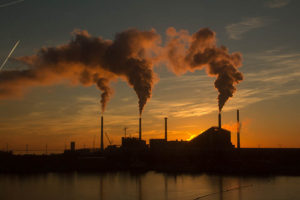Every year, 42,100 Nepalese die due to the effects of air pollution. Globally, the number of deaths caused by reaches 6.67 million. These numbers might be startling to many who are unfamiliar with the devastating effects of air pollution, but the death count stands as a reminder that every day that we go about our day, breathing in and out, we might be getting closer and closer to an early grave.
The State of Global Air Report 2020 published by the WHO states that air pollution is the fourth leading risk factor for early death around the world, and the leading environmental risk factor for death. Its impact is surpassed only by high blood pressure, tobacco use, and poor dietary habits. Ongoing research is showing that air pollution, even in low levels for a sustained period of time, can have negative impacts on health. Given that Nepal ranks very high in terms of air pollution, we must be concerned about air pollution more than ever.
Air pollution has both short-term and long-term impact on health. Short-term exposure to air pollution can trigger asthmatic symptoms, lead to skin and eye irritation, and even cause a spike in hospitalization related to respiratory and cardiovascular health. “There are six major air pollutants that we must be concerned about—nitrogen dioxide, sulphur dioxide, lead, carbon monoxide, particulate matter, and ozone,” says Dr. Prajwol Shrestha, Consultant, Pulmonary Medicine, Intensivist, and Sleep Specialist at Grande International Hospital. “Immediate effects of pollutants like nitrogen dioxide and sulphur dioxide include eye irritation, cough, and throat irritation,” he adds.
“Most patients come to the hospital due to short-term effects of air pollution. They come with allergies, dry cough, nasal infections, bronchitis, eye and skin irritations, etc.,” says Dr. Kundan Singh Karki, Consultant Pulmonologist at the same hospital. However, patients who suffer from chronic lung conditions like COPD (chronic obstructive pulmonary disease) and bronchial asthma are prone to exacerbated symptoms, such as breathlessness, coughing, etc. due to exposure to high levels of air pollution. .
Long-term exposure to air pollution causes and exacerbates the condition of several non-communicable diseases. In 7 out of 10 leading causes of death worldwide, air pollution is an important causative factor. Long-term exposure is shown to increase the risk of illness and death from ischemic heart disease, lung cancer, COPD, lower-respiratory infections (e.g. pneumonia), stroke, and type 2 diabetes. Recent studies have also shown that air pollution can have an impact on maternal and child health, leading to miscarriages, low weight at birth, and other adverse birth outcomes.
According to the State of Global Air Report, air pollution is responsible for 20% of deaths related to ischemic heart diseases, 26% of deaths due to stroke, 40% of deaths due to COPD, 30% of deaths due to lower respiratory infections, 20% of deaths due to neonatal conditions, 19% of deaths due to lung cancer, and 20% of deaths due to diabetes.
Different air pollutants affect our bodies in different ways. One of the most common air pollutants, particulate matter (PM), are tiny dust particles suspended in the air. PM10 are larger particulate matter (10 micron in diameter or less) that lodge in our skin, eyes, and nose, and cause irritation. PM2.5 (particulate matter with a diameter of 2.5 microns or less) are smaller particles that bypass the natural filters in our nose and trachea and reach our lungs. About 7% of deaths worldwide can be attributed to PM 2.5 exposure. Nepal has the second highest level of particulate matter (PM2.5) pollution in the world, after India.
“PM2.5 can reach the distal airways in our lungs, and from there they can get into our systemic circulation. Through the systemic circulation, it reaches our heart and is pumped out to the rest of the body through the blood vessels. This causes inflammation in the body and activates inflammatory cytokines, which affect our heart and circulatory system. It leads to issues such as hypertension, heart attacks, heart failures, and disturbance in the rhythms of the heart,” explains Dr. Shrestha. “In the brain and nervous system, this reaction can lead to stroke and dementia.”
Similarly, other air pollutants impact our bodies in different ways. Sulphur dioxide, which is released during burning of coal, leads to increased hospitalization among children with asthma. Nitrogen dioxide and ozone exposure lead to higher airway reactivity, and exposure to lead pollution shows neurobehavioral and cardiovascular effects. Polycyclic aromatic hydrocarbons, which are formed when burning organic matter, can affect the immune and reproductive systems, cause cancer, and even affect the DNA. Burning of plastic releases dioxins, furans, mercury, and polychlorinated biphenyls (better known as BCPs), which are highly toxic and can cause cancer and reproductive and developmental problems, besides damaging the immune system and interfering with hormones.
Effects of air pollution are seen more in high risk groups, which include pregnant women, senior citizens, and people with chronic illness that affect the heart and the lung. “Among pregnant women, exposure to carbon monoxide, lead, and ozone can lead to growth retardation in unborn children, low birth rate, and defects in the heart valve of children,” states Dr. Shrestha. “Mitigating air pollution can lead to a 7% decrease in miscarriages in Asia and save the lives of seven lakh children worldwide every year.”
Among patients with chronic illnesses, such as hypertension, COPD, and asthma, exposure to air pollution exacerbates the symptoms they face, leading to more hospital visits and medications. Extremely high air pollution events can be deadly to such patients, as they can lead to death. A popular air pollution incident that often gets cited in academic circles is the “London Smog Incident”. In 1952, between December 5 and 9, the city was covered in a toxic smog caused by pollution from the industries, and intensified by a weather event called temperature inversion, wherein the difference in air temperature in different layers of atmosphere cause the pollutants to be trapped in place without dispersion or dilution. During these five days, more than 4000 people died due to the toxic smog.
Exposure to air pollution has often been compared to smoking cigarettes, especially given that long-term exposure to air pollution can lead to lung cancer. Dr. Karki explains it thus: “Exposure to multitudes of air pollutants like ozone, nitrogen dioxide, sulphur dioxide, lead, and carbon monoxide can cause inflammation and constriction of airways in the lungs, which is similar to the effects of smoking tobacco.” Furthermore, COPD, which is a disease often associated with tobacco smokers, is becoming more and more common among non-smokers, as well, due to high exposure to air pollution. “Around 30% of COPD patients around the world are non-smokers. This is another effect of air pollution,” says Dr. Shrestha. He estimates that the percentage of non-smokers with COPD is possibly higher in countries like Nepal due to the use of biomass, such as firewood for cooking indoors, which leads to indoor air pollution.
Indoor air pollution is considered particularly harmful, because there is comparatively little dilution through windows and ventilation, and the pollutants remain in place for a longer time. Indoor air pollution particularly affects the health of mothers and children, because they are more likely to stay indoors and thus are exposed for a longer time. In poor countries like Nepal, where fuel wood is still used in rural areas for cooking and heating purposes, mothers and infants are highly prone to exposure to indoor air pollution. Air pollution is also shown to trigger and exacerbate neurological conditions like Alzheimer’s disease and dementia. Some studies show that air pollution can even decrease immunity and make one more prone to viral infections, including COVID-19.
In the last 15 years, partially due to rising air pollution, and partially due to better diagnostic tools, health issues related to air pollution are on a rising trend, according to Dr. Karki. He suggests that professionals working in fields like welding, brick kilns, furnaces, and industries/factories that burn kerosene and fossil fuel are highly susceptible to the long-term adverse effects of air pollution due to high exposure. He recommends that such professionals use proper safety gears while working.
Air Quality Index (AQI) is an index that shows the level of air pollution on a daily basis. AQI above 150 is considered harmful to health, and above 300 is considered an emergency situation. Reducing the air pollution level in Kathmandu will require a lot of effort from the government in terms of controlling vehicular emission, fast tracking the construction and maintenance of roads, and controlling burning of household waste. But for the general people, the doctors suggest making a habit of wearing masks outdoors if the AQI rises above 150.
 Medicosnext
Medicosnext





